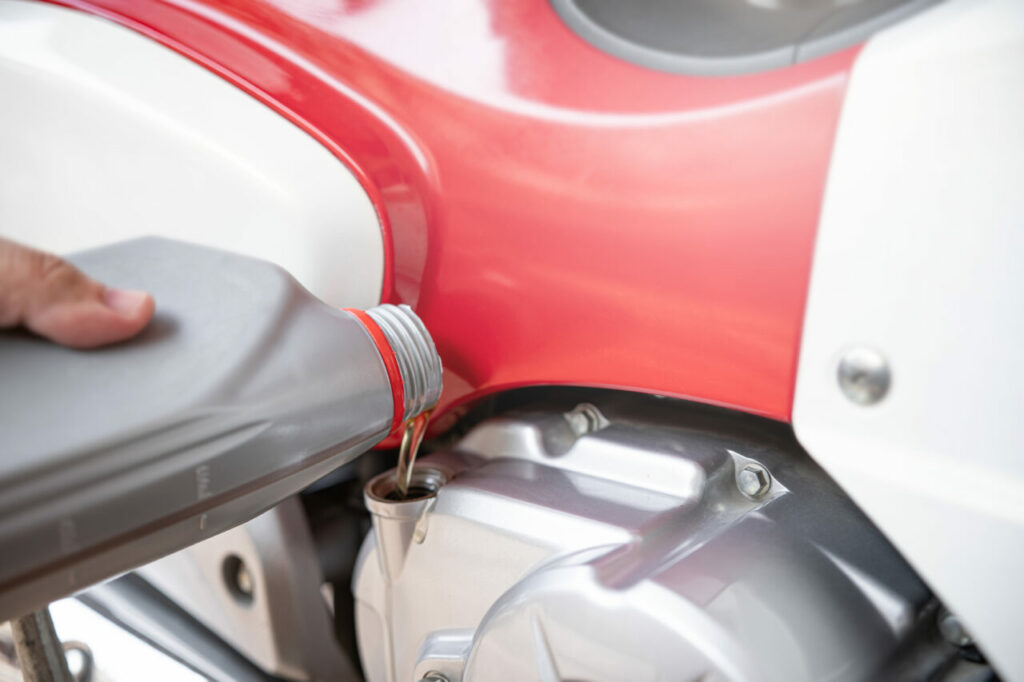Engine oil is without doubt the life blood of our motorcycles! And possibly one of the most conversational grenades you could ever throw into a conversation about bikes! For everything you need to know continue reading this motorcycle engine oils guide.

Let’s face it – without it, none of the engine’s components would be too happy and it wouldn’t be long before our engines just resembled a lump of seized, solid metal and a dead motorbike. Granted, the last statement is a little excessive and none of us would ever run our bikes without oil, but if we use the wrong oils, run the engine oil low, or go over the service intervals regularly, we can cause our engines damage and reduce our bikes performance…

Why Bikes Need Oil
The oil in our bikes needs to be able to lubricate the internals of the engine – reducing the amount of friction, and less friction means less heat and more power! The correct oil for your bike will help to reduce friction and carry heat away from the lubricated parts, whilst cleaning the engine’s internals in the process, as well as this it stops seals drying out and failing.
So, the right type and amount of oil is recommended for maximum performance and protection, but so are the recommended service intervals! We can use the best oil on the planet, but if we use it for too long between changes, the additives used to keep our engines clean will eventually lose their effectiveness and then sludge build up and component damage can occur!
Now we’re not saying that if you go over by a few miles, or have a few hundred ml too little oil in your bike that you’ll have problems! Not at all!! In this article, we just want to go through the different types of oil available, give you some examples of popular oils in the UK and dispel the myth that you have to use the best oil money can buy! If you use the right quantity and grade of oil and follow the service intervals you will be fine (and so will your wallet!).

Types Of Engine
The 2 common types of engine are 4-stroke and 2-stroke.
4-stroke engines use the same oil for the engine, clutch and gearbox (apart from bikes with dry clutches obviously!) and the oil needs to be changed at regular intervals. If not, the oil will degrade – leading to reduced performance, deposit build ups and engine component wear (it is also necessary to change the oil filter every change, even if it’s only been a few thousand miles).
2-stroke engines are different, with a separate gearbox, as their crankcases form part of the induction system, meaning the engines lubricating oil must be mixed with the fuel in order for it to be distributed around the engine (either mixed directly in the fuel tank, or from a separate oil tank through an injector).

4-Stroke Engine Oils
Older Classic bikes still use monograde oils, whilst all modern motorcycles use various types of multi-grade oils, including:
Mineral oils are essentially the most basic type of engine oil and are usually recommended for smaller capacity bikes that do not have highly stressed motors. Mineral oils are also relatively cheap in comparison and therefore, kind on your wallet as well as your engine! The only downside is that they don’t last as long as synthetic oils, but even with frequent changes, it is still an affordable option.
Semi-synthetic oils are, as the name suggests, a mixture of a mineral based and a synthetic oil (usually no more than 30% synthetic), with the ability to protect your engine against higher temperatures and load. Semi-synthetic oils are normally used in bikes that are not put under a lot of stress, but still have a healthy power output making this style of engine oil perfect for commuters and leisure riders on larger bikes.
Fully synthetic oils are the cream of the crop! Unlike a mineral oil, a fully synthetic oil will have all its impurities removed and will be enhanced with additives to offer ultimate protection to your engine. A fully synthetic oil is more suited to track day bikes and race bikes where the engine is constantly under extreme stress, and the use of an oil that offers maximum lubrication without the rapid deterioration of a mineral or semi-synthetic oil.
2-Stroke Engine Oil
Just like four-strokes, two stroke oils are available in many different types, depending on the bike. Two stroke oils can be mineral, (or castor) based, semi synthetic or fully synthetic and depending on the type of oil and machine, the fuel-to-oil ratio mix could be anything from 16:1 to 100:1!
Some scooters and lower powered engines can use the most basic of two stroke oils, but it is always preferable to buy the best two stroke oil you can (whether pre-mix or auto lube), as most modern day synthetic two stroke oils burn a lot cleaner, reduce emissions and drastically reduce oily deposits on spark plugs.

Engine Oil Viscosity And Grades
The viscosity of your oil is measured by its resistance to flow. This means that your oil must be capable of flowing at low temperatures, so that it gets round the engine quickly on start up to protect the components, but it must also be capable of protecting our engines at high temperatures without evaporating and keeping the oil pressure at a good level throughout.
On a multi-grade oil, there are 2 numbers – the first is commonly 0, 5, 10, 15 or 20 and is followed by a “W” which stands for winter – not weight as many believe. The second number is always higher and is usually 20, 30, 40, 50 or 60.
When multi-grade oils first hit the market, a winter test was introduced to see how well all oils flowed at low temperatures. We all know oil is thicker when it is cold compared to when your engine is warm, but the lower the first number, the quicker the oil will flow when it is cold.
The second number is known as the SAE (Society of Automotive Engineers) this refers to the oils resistance to flow (viscosity) at 100°C through a standard orifice. The thicker the oil – the higher the value, the lower the value the thinner the oil. Your handbook will specify what grade of oil your bike needs, but it is handy to know what the numbers mean – especially if your handbook lists different grades for different markets around the world.
Example Oils
Below are just a few popular examples of good quality oils available to show the different brands and pricing.
Popular 4 stroke engine oils:
Motul 5000 10W-40 semi synthetic
Motul 7100 fully synthetic 10W-40
Putoline Ester Tech 4+ fully synthetic
Popular 2 stroke engine oils:
Enjoyed this? Read more of our latest news:
Where To Next?
Looking for the latest motorcycle parts and accessories? Check out our wide range from top brands.
Come and visit us at our store, showroom and fitting centre in Wrexham.
Want to know more about our story? Learn about who we are and why we’ve been driven by passion for over 50 years.
Interested in everything we do? Catch up on all the latest Demon Tweeks news.
